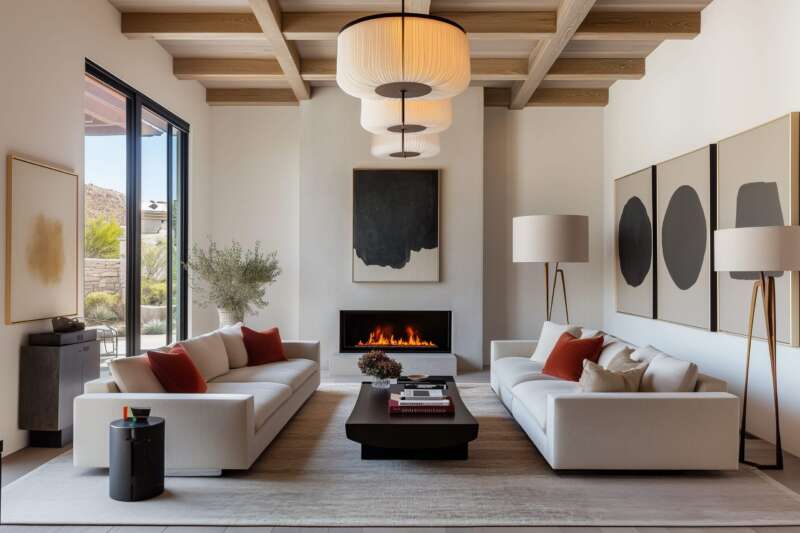Cathedral Ceilings Lightings
Cathedral ceilings originated in cathedrals but have become popular in modern and traditional homes. In architectural terms, vaulted ceilings refer to ceilings with self-supporting arches. Cathedral ceilings angle up from the side walls of a room to a central point, creating a volume of space overhead that is higher than the standard flat ceiling height of eight to ten feet.
Taking advantage of unused space by flat ceilings, various styles of vaulted ceilings are available to suit any home decor. They can be used anywhere in your home where they are structurally suitable; however, they are most common in living or dining rooms.
Factors to consider when lighting cathedral ceilings
Due to its unique design, lighting Cathedral ceilings is slightly difficult as there are several factors you need to consider. These factors will help you determine the best lighting fixtures for your ceiling.
Room measurements
The height and size of your room with the Cathedral ceiling are crucial in ensuring you find the right lighting fixtures. Rooms with Cathedral ceilings will often be tall, so you may need to add extra eye and ground level lighting to cover all areas. Some lighting fixtures may not reach all corners of your room, which could increase the need for floor or wall lights.
If you are installing pendant lights in a Cathedral ceiling, you should ensure that the ceiling rose is positioned on an even surface. Having an even surface is essential for stability and aesthetics. The ceiling rose should fit comfortably at the apex of the cathedral ceiling. A disproportionate ceiling rose can detract from the overall look.
Rule of thirds
The rule of thirds rule is installing light fixtures at the top, middle and bottom of a room to distribute light evenly. Recessed ground lights or table lamps are two great lighting examples for supplying light to the bottom and middle of a room, while pendant lights or chandeliers can provide the top of the room with light. As Cathedral ceilings are usually high, the rule of thirds is a great guide to ensure any area is not oversupplied.
Room usage
How you will use the room with a Cathedral ceiling could affect the lighting fixtures you opt for. If your Cathedral ceiling is in the kitchen or living room, you may want to install lighting highlighting a main table or kitchen island to provide extra light when carrying out tasks.
What is the best lighting fixture for Cathedral ceilings?
After considering the factors above, you can establish which lighting fixtures will be most suitable for your Cathedral ceiling. Read on for lighting ideas to brighten your room at every level.
Pendant lighting
Cathedral ceilings leave a lot of space to be filled, which is why hanging pendant lighting is a fantastic option. It is advisable to avoid fixtures with multiple pendants if your cathedral ceiling is sloped. Installing multiple pendants can result in them bunching together and creating an unattractive, cluttered appearance due to the ceiling’s angle.
Pendant lighting is an excellent option if you want to add an extra focal point to your room. No matter what decor you have.
Chandeliers
Much like pendant lighting, chandeliers are ideal for lighting Cathedral ceilings as there is plenty of space to be filled. Luxurious chandeliers are exceptional for giving any room in your home a sense of sophistication. Chandeliers are highly reflective and contain multiple bulbs, which make them perfect for illuminating large areas. Living or dining rooms are ideal for a chandelier, as they brighten the whole room and add a focal point for guests.
Accent lighting
Accent lighting is a fantastic way to ensure all areas of your room are well-lit. If you install pendant lighting or chandeliers in a room with a Cathedral ceiling, some areas may still be quite dark. Adding wall lights or table lamps will help you follow the rule of thirds and include extra design features in your home. Incorporating light at different levels will balance the light flow.
Natural lighting
Adding a Cathedral ceiling to your home will open up space for floor-to-ceiling windows, adding more natural light to any room. Natural light is a great lighting alternative during the summer, as long daylight hours will help you save substantial money on energy bills. Adding floor-to-ceiling windows will illuminate your interior but could also increase your home’s value. Natural lighting also provides several health benefits, such as improving sleep and reducing depression.








